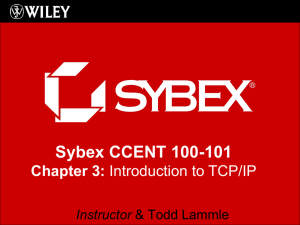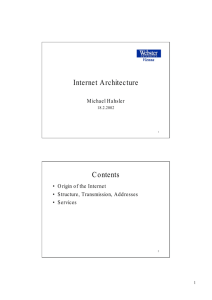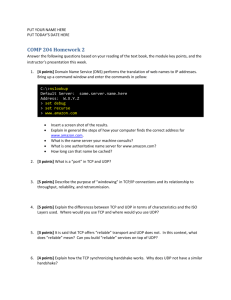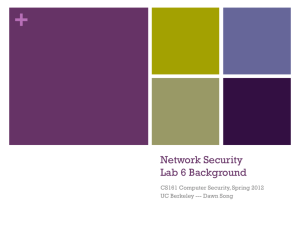Hacking_Exposed_7_ch3
advertisement
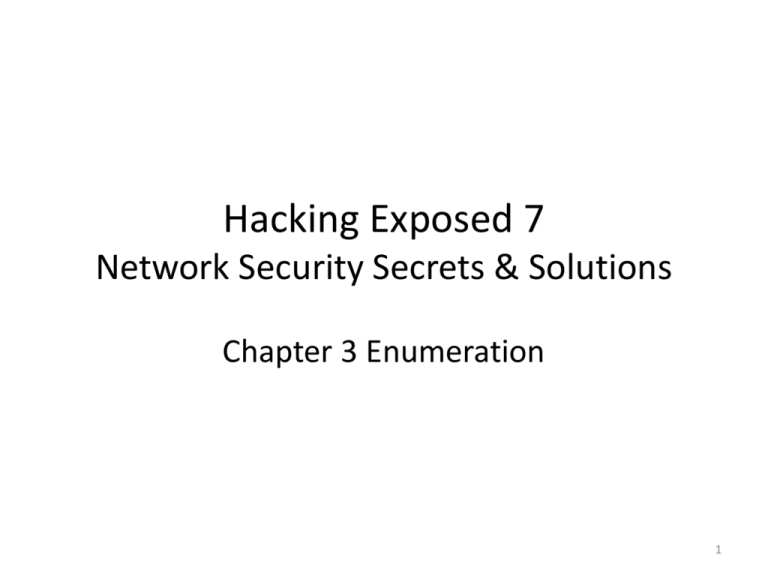
Hacking Exposed 7 Network Security Secrets & Solutions Chapter 3 Enumeration 1 Enumeration • • • • Service fingerprinting Vulnerability scanners Basic banner grabbing Enumerating common network services 2 Prelude • Scanning vs. enumeration – Level of intrusiveness – Enumeration: active connections to systems and directed queries • Generic : banner grabbing • Platform-specific: dependent on port scans and OS detection • Enumerated info – User account names – Misconfigured shared files – Older software versions with known vulnerabilities • Common services with fruitful enumerated info – ftp (21), telnet (23), smtp (25), etc. • Binding from ports, services, protocols, to software 3 Service Fingerprinting • Revision/patch level with service ports • Manual vs. automatic – Stealth vs. efficiency • Nmap version scanning – nmap-services (mapping ports to services) vs. nmapservice-probe (known service responses known protocol and version) • Hidden services: e.g. Timbuktu vs. OpenSSH (on TCP port 1417) • Amap version scanning – Second opinion to Nmap – Another service pattern-matching technique 4 Vulnerability Scanners • Database of known vulnerability signatures • Free scanners (Nessus, OpenVAS - Open Vulnerability Assessment System) vs. commercial ones from McAfee, Qualys, Rapid7, nCircule, Tenable • Nessus by Tenable – Exhaustive scanning – Custom plug-ins using Nessus Attack Scripting Language (NASL) – Free and open source till version 3 (proprietary closed source) • Nessus scanning countermeasures – Effective patch and configuration management – IDS/IPS: alert on Nessus behaviors, slow scans down to redirect hackers to softer targets • Nmap vs. Nessus – Wider (not as powerful in vulnerability scanning) vs. focused – Nmap Scripting Engine (NSE) – A library of NSE scripts • Network discovery, version detection, backdoor detection, exploitation of vulnerabilities 5 Basic Banner Grabbing • Banners in the responses to requests • Manual – telnet – Generic to work on many common applications on standard ports, e.g. HTTP (80), SMTP (25), FTP (21) • Automatic – netcat or nc – Redirect an input file of requests to nc • To grab more outputs in responses • Vendor and version of software known vulnerabilities • Banner grabbing countermeasures – Shut down unnecessary services – Access control lists – Try to disable the presentation of vendor and version in the banners 6 Enumerating Common Network Services (1/5) • FTP on TCP 21 – Still popular for Web content uploading – Public sites (listed in ftp-sites.org) often configured for anonymous access for sensitive contents • FTP enumeration countermeasures – Use secure FTP (SFTP with SSH encryption) or FTP secure (FTPS with SSL) – Watch out anonymous FTP, disallow unrestricted uploading – Use HTTP instead to offer public content • Telnet on TCP 23 – Transmit data in cleartext: sniffed easily – Still commonly available, being replaced by secure shell (SSH) – System enumeration: display a system banner prior to login: host’s OS and version, or vendor, explicitly or implicitly – Account enumeration: attempt login with a particular user and observe error messages • Valid/invalid username & invalid password a list of valid accounts • Telnet enumeration countermeasures – Use SSH if possible – Modify banner info – Reconnect between failed login attempts 7 Enumerating Common Network Services (2/5) • SMTP on TCP 25 – User enumeration by two built-in commands • VRFY: confirms valid user names • EXPN: reveals actual delivery addresses of aliases and lists • By telnet or netcat, or an automatic tool vrfy.pl • SMTP enumeration countermeasures – VRFY & EXPN: disable or require authentication • DNS on TCP/UDP 53 – Normally on UDP 53; TCP 53 for zone transfer – DNS enumeration by zone transfer on misconfigured DSN servers: dump entire zone files (A and HINFO records) • nslookup, ls –d , <domainname>; or dig – BIND enumeration: dig to get version.bind – DNS cache snooping: dig +norecurse to request DNS server to query only its cache deduce if a client has visited a particular site – Automatic DNS enumeration: dnsenum & fierce.pl • Domains servers, subdomains, IP addresses • CentralOps.net hosts web-based tools for attackers to stay hidden • DNS enumeration countermeasures – Block zone transfers (to authorized machines only), block BIND version.bind 8 requests, disable DNS cache-snooping Enumerating Common Network Services (3/5) • TFTP on UDP 69 – Trivial FTP: UDP-based, unauthenticated, quick & dirty, have to know the file name – To grab a poorly secured /etc/passwd: tftp (connect, get) – To access router/switch configurations: look for config • TFTP enumeration countermeasures – Inherently insecure • Don’t run it; or wrap it to restrict and log access with TCP wrappers, limit access to /tftpboot, block at firewall • Finger on TCP/UDP 79 – Name, idle time of logged-on users • Finger enumeration countermeasures – Don’t run finger (comment out in inetd.conf, killall –HUP inetd); block port 79 at firewall, use TCP wrappers 9 Enumerating Common Network Services (4/5) • HTTP on TCP 80 – telnet & netcat (nc): to get banner info – For SSL-enabled website • Redirect to SSL proxy (sslproxy) or use SSL client (openssl) – Automatic tool: Grendel-Scan • Look for comments, robots.txt file, directories, etc. • HTTP enumeration countermeasures – Change the banner info • Server vendor dependent 10 Enumerating Common Network Services (5/5) • Other services – Microsoft RPC endpoint mapper on TCP 135: epdump, rpcdump.py – NetBIOS name service on UDP 137: net view, nltest, nbtstat, nbtscan, nmbscan – NetBIOS session on TCP 139/445: net use, net view – SNMP on UDP 161: snmputil, snmpget, snmpwalk – BGP on TCP 179: telnet – LDAP on TCP/UDP 389/3268: Active Directory Administration Tool – UNIX RPC on TCP/UDP 111/32771: rpcinfo – rwho and rusers – SQL resolution service on UDP 1434: SQLPing – Oracle TNS on TCP 1521/2483 – NFS on TCP/UDP 2049 – IPsec/IKE on UDP 500 11 Summary • Enumeration seal the lips of loose-talking software reduce the info leaks – Fundamental OS architectures • Lock down by disabling or restricting access – SNMP • Default community string “public” give out data to unauthorized users – Leaky OS services • Services such as finger and rpcbind give too much info – Custom applications • Built-from-scratch more info given out – Firewalls • Patching holes in software vs. screening by firewall 12 Homework #2 Ch2 & Ch3 (total: 180) Due: 4/21 (Mon) in midterm in printed hardcopy (format: problem, solution with explanation, screen dumps) 1. (50 points) Select a target domain and use Nmap for the following tasks. a) b) c) d) e) 2. 3. 4. 5. 6. 7. host discovery on the selected domain, port scanning on a selected host, active stack fingerprinting on the selected host, version scanning on a selected port, vulnerability scanning on the selected port. (20 points) List and compare nmap-os-fingerprints used in Nmap and osprints.conf used in Siphon. Discuss how and why they differ. (20 points) List and compare nmap-services and nmap-service-probe. Discuss how and why they differ. (10 points) On a UNIX/Linux host, list /etc/inetd.conf. Discuss what services are being offered. (30 points) Select a target domain, run metaexploit with Nmap scans and import Nmap results into the database. Show found hosts and available ports. (30 points) Select a website to do banner grabbing with telnet, netcat, and grendel-scan, respectively. Show and compare their results. (20 points) Select a target domain to do automatic DNS enumeration by dnsenum to find subdomains, servers, and their IP addresses. 13
